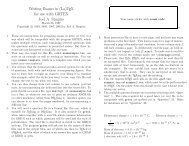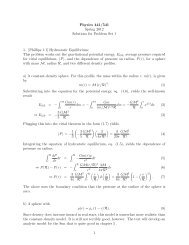Solutions
Solutions
Solutions
You also want an ePaper? Increase the reach of your titles
YUMPU automatically turns print PDFs into web optimized ePapers that Google loves.
MasteringPhysics: Print View with Answers http://session.masteringphysics.com/myct/assignmentPrin...<br />
ANSWER:<br />
Doorway Diffraction<br />
Description: Use Fraunhofer diffraction to calculate the angle within which a person would not hear a sound from a room as it passes through<br />
a door.<br />
Part A<br />
The width would increase.<br />
The width would decrease.<br />
The width would not change.<br />
Sound with frequency 1280 leaves a room through a doorway with a width of 1.18 . At what minimum angle relative to the centerline<br />
perpendicular to the doorway will someone outside the room hear no sound? Use 344 for the speed of sound in air and assume that the<br />
source and listener are both far enough from the doorway for Fraunhofer diffraction to apply. You can ignore effects of reflections.<br />
Express your answer in radians.<br />
Hint 1. How to approach the problem<br />
For diffraction patterns in light there are a number of dark fringes in which waves of light completely cancel each other. For sound<br />
waves this cancellation corresponds to silent spots at certain angles.<br />
In this problem, we would like to know the angle at which the sound is completely canceled out. In order to determine this angle, we<br />
first need to find the wavelength of the sound wave. This can be determined from the speed of sound and the frequency. You can then<br />
determine the angle to the first destructive diffraction point from the standard Fraunhofer diffraction equation.<br />
Hint 2. The equation for "dark" fringes<br />
For single-slit Fraunhofer diffraction, the equation that relates the angle between subsequent dark (in this case silent) fringes and the<br />
centerline to the wavelength of the incoming sound wave is<br />
where is the wavelength of the sound, is the width of the diffracting slit, and is the angle between the th dark fringe and the<br />
centerline of the image (see the figure).<br />
Hint 3. Find the wavelength of the sound wave<br />
Calculate the wavelength of the sound wave.<br />
Express your answer in meters.<br />
10 of 11 2/7/13 1:01 PM<br />
,











![More Effective C++ [Meyers96]](https://img.yumpu.com/25323611/1/184x260/more-effective-c-meyers96.jpg?quality=85)





